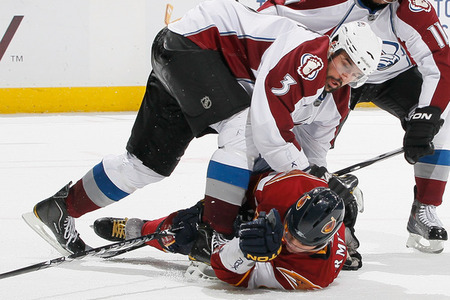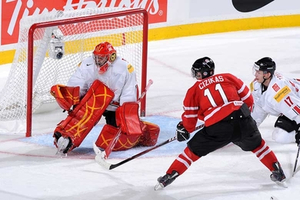 |
Canada is off to the gold medal game for the tenth straight year.
Photo: Matthew Manor / HHOF-IIHF Images |
As an American, last night was painful. I don't just mean the loss, but also how it came about. If I was going to write this recap as a fan, I'd say Team USA lost because they didn't get the bounces or Canada's
Mark Visentin stood on his head, stopping all but one of USA's chances. While both those things are true, the reality is that Team Canada was the better team last night. They came out hitting hard and taking away the lanes, disrupting the Americans' game. And it worked. Brilliantly. The final score was 4-1 Canada; if not for the spectacular effort by USA goaltender
Jack Campbell, the Canadians would easily have scored another four more.
From the very first puck drop until the final horn, the Candadians dictated the pace of play. 2:38 into the first, Canada started their scoring as
Cody Eakin dropped a pass to
Curtis Hamilton who got a shot off and then tapped in his own rebound. Shots were limited by both teams early on as both sets of defense were doing a good job of forcing turnovers. But Canada was hitting anything and everything they could, and the US was just taking it, rarely hitting back. In the end, I personally think this was their downfall. Canada just wasn't worried about standing them up at their blueline because they knew the USA wouldn't punish them for being there.
After about ten minutes of entertaining back and forth plays, Canada netted their second of the night. Visentin passed the puck up to
Brett Connolly who led a three on two into the Americans' zone. He slipped a pass across the circles and Quentin Howden tipped it in. After this goal, the momentum was all on Canada's side, and the US was completely on its heels. By the end of the first, the score was 2-0 Canada, and shots on net were 12-5 Canada.
The second period looked pretty much the same as Team USA had a hard time even getting in through center ice. By the time they did, their lines were so tired, they'd have to go for a change - unable to set anything up. Canada took the first penalty of the night as Howden accidentally whacked Campbell in the head. At first look, it seemed like a bad call, but watching the review, it was clear that Howden kept trying for the rebound even after it was clearly covered. That's when he hit Campbell. Still, I don't think it was intentional.
Canada immediately started out on an aggressive penalty kill, and the US wasn't able to get much set up. They had a few good chances, but Visentin was there to stop them. Then just as Canada's penalty expired,
Charlie Coyle of the US was called for high sticking. Within seconds, the Americans were called for another penalty, this time hooking on Patrick Wey. At first, it seemed the penalty killers might have been on their way to shutting Canada down. However, Campbell was just having to do too much. On a frenzied shot, he made the initial save, but he couldn't control the rebound. His defenders weren't there to clear it out for him either. Campbell almost got his glove on it, but
Ryan Johansen was too quick and sent the rebound in.
The Canadians were still on a 4-on-5 power play, but the US limited their chances after the goal. Over the next few minutes, Campbell showed why he's so highly valued as a future NHL goaltender. Play after play, Canada would use their physicality and strength to enter the offensive zone, set up some good cycling, and battle away in the crease. Campbell made save after save: from the blueline in traffic, at the side of the net against a wrap around attempt, in the crease with a mass of bodies fighting for the puck. I kept shaking my head, wondering how the hell he was able to stop the ones he did.
On the few saves he had to make, Visentin controlled his rebounds. Unfortunately for the United States, those garbage goals in front of the net have been a big part of their game. They were also losing all the battles in the corners, but they drew some penalties nonetheless. With less than four minutes to go in the period, Canada's Calvin de Haan went off for hooking and sent the USA on their second power play of the night. The Americans did a better job of setting up this time around, but even on some great chances, Visentin kept them off the scoreboard with fantastic saves. Canada went into the locker room leading the United States 3 to1.
Shortly into the third, I saw the worst non-call of the tournament so far. Right in front of the ref - actually, right next to him as he got jostled around in the process - Canada's
Marcus Foligno joined his buddy as he was hitting an American player along the boards at the Canadian bench. But instead of finishing his check and skating away, Foligno grabbed the American and shoved him literally into the bench face first, completely taking him out of the play, one that was developing into a rush for the US. The ref just kind of got out the way and steadied the American without saying a word. Horrid display of officiating.
At approximately the 3 minute mark,
Carter Ashton of Canada went out for slashing, Again, the United States was able to get a bit of pressure on them, but between Visentin and Canada's defense, there wasn't any scoring. Immediately after the penalty expired,
Zack Kassian got a breakaway and increased Canada's lead to 4-0.
USA was still fighting and got another good opportunity, but Visentin made a fantastic glove save and held on for the face off. With a little more than 10 minutes to go, Johansen took a hooking penalty, and Team USA got their 4th power play opportunity of the night. This time they converted as
Jeremy Morin got off a shot from the point, defenseman
Nick Leddy knocked it down, and Chris Brown picked it up off a bounce at the bottom of the circle, beating Visentin short side. 4-1 Canada.
The Canadians didn't let up at all, though, and Charlie Coyle uncharacteristically mishandled the puck, shooting it over the glass for a delay of game penalty. This time, the USA was extremely aggressive on the PK and not only killed it, but forced a couple of strong short-handed chances. They couldn't find the back of the net again, however, and Canada won with a final score of 4-1.
Quotes for the night:
Jack Campbell of the USA:
"I think nobody in the locker room can go around and say he played his best, including myself. I never went through this before. We were shot down by a great Canadian team, and it's really hitting me."
Marcus Foligno of Canada:
"Our transition game was very fast. We came up early. We played well in the defensive zone, and we kept up the pace. We wanted to do a statement."
Players of the Game:
USA - Jack Campbell (37 saves)
Canada - Mark Visentin (22 saves)
(Both goalies truly deserved these honors; still, Campbell looked equally pissed and devastated when accepting the award. He did everything he could to keep his team in it, but they just completely let him down.)
Next Up:
USA fights for the bronze v. Sweden, Wed. Jan 5 at 3:30 MT/7:30 ET
Canada goes for gold against the surprising Russians, Wed. Jan 5 at 5:30 MT/7:30 ET









